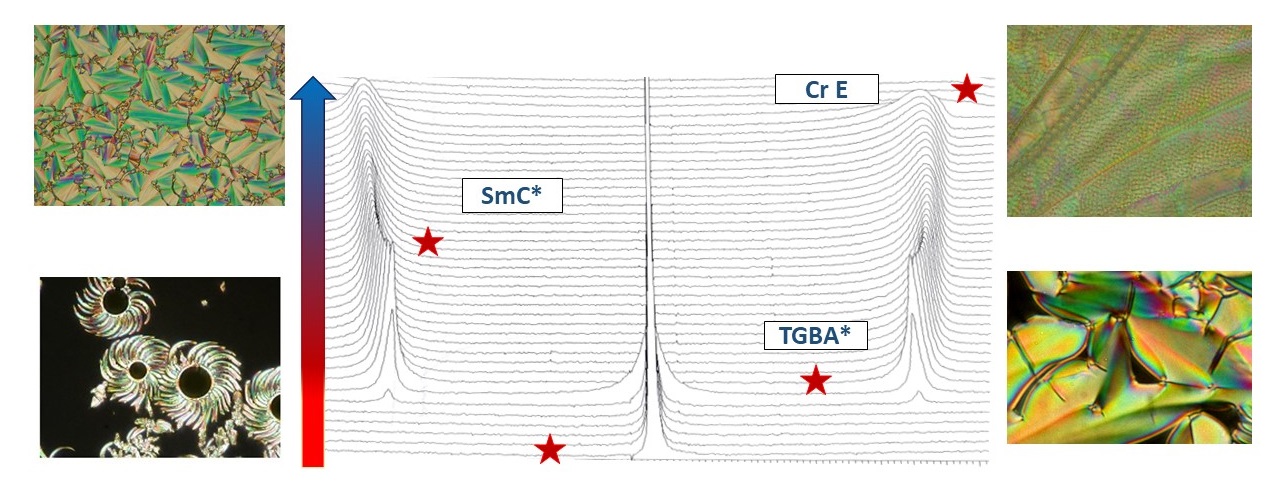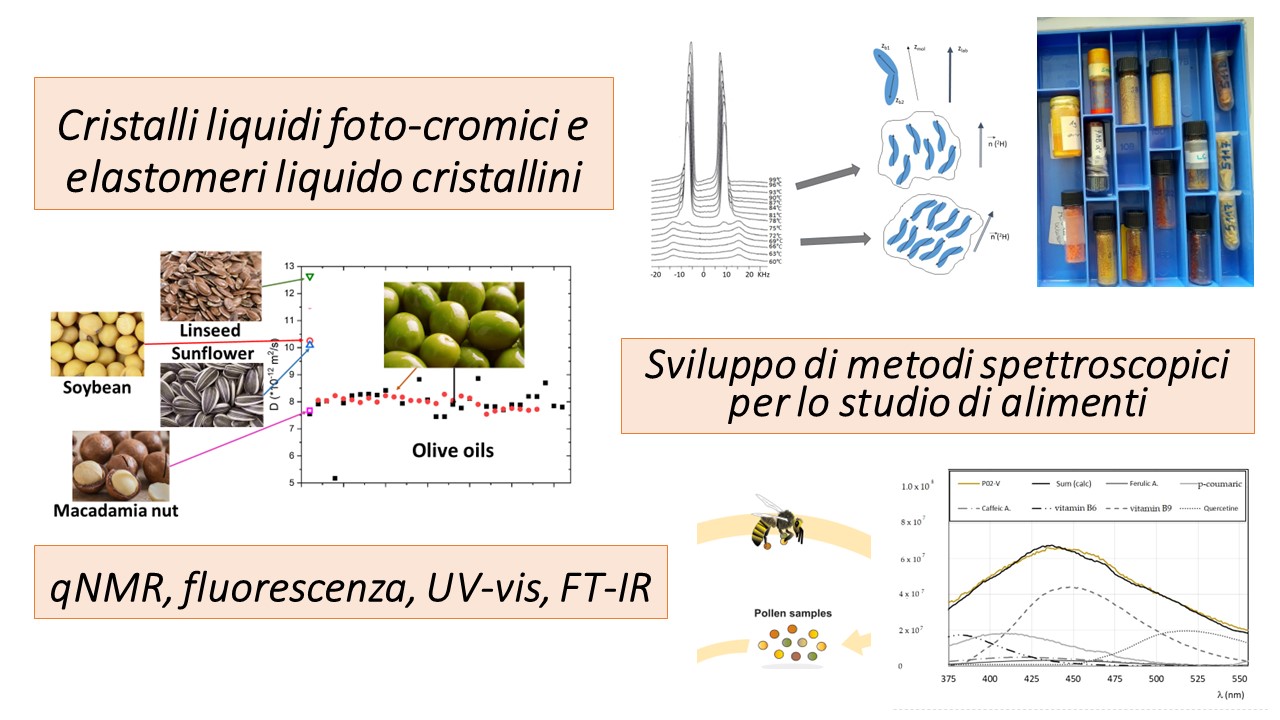• Study of Liquid Crystals by means of Nuclear Magnetic Resonance

We study the orientational ordering properties and dynamics of new liquid crystalline phases by means of Nuclear Magnetic Resonance (2H NMR, 19F NMR, 1H NMR...). The analysis of NMR spectral features allow us to get insights into conformational properties, supramolecular and molecular packing and self-assembling properties as well as to investigate the effect of external magnetic fields on the supramolecular structure of liquid crystals and their mesophases. 1H NMR relaxometry and 1H NMR diffusometry help us in the understanding of molecular motions active in different frequency regimes as a function of temperature in the different mesophases.
Selected recent papers:
1. Alexej Bubnov et al. “Mesomorphic, structural, electro-optic and dynamic properties of lactic acid derivative and its selectively deuterated isotopomers by means of electro-optics, SAXS, H-2-NMR and neutron spin-echo spectroscopy”, LIQUID CRYSTALS, 2019, 47, 1999-2015.
2. Mario Cifelli et al. “N-15-C-13 Dipole Couplings in Smectic Mesophase of a Thermotropic Ionic Liquid”, APPLIED MAGNETIC RESONANCE, 2018, 49, 553-562.
3. Maria Ghilardi et al. "Comparative H-2 NMR and X-Ray Diffraction Investigation of a Bent-Core Liquid Crystal Showing a Nematic Phase", CRYSTALS, 2020, 4, art. n. 284.
• Liquid Crystalline Elastomers and Soft-Soft Composites

Since 2006, we have contributed to the design of new Liquid Crystalline Elastomers (LCEs) and composite materials based on LCEs for applications as actuators and artificial muscles. The chemical-physical characterization of these soft materials, such as the new Polymer-Dispersed Liquid Crystal Elastomers (PDLCEs) is done by means of a combination of physical and chemical-physical techniques. The study of the orientational and dynamic properties of LCE-based materials by means of different NMR tecniques (i. e. 2H NMR and 1H NMR) was very important in order to optimize their preparation and to fully characterize at a molecular level their actuation mechanisms.
Selected recent papers:
1. Vanessa Cresta et al. “Nanostructured Composites Based on Liquid-Crystalline Elastomers”, POLYMERS, 2018, 10(7), 773. Link: http://www.mdpi.com/2073-4360/10/7/773
2. Andraz Resetic et al. “Polymer-Dispersed Liquid Crystal Elastomers”, NATURE COMMUNICATIONS, 2016, 7, 13140. Link: http://www.nature.com/articles/ncomms13140
3. Andraz Resetic et al. "Deuteron NMR investigation on orientational order parameter in polymer dispersed liquid crystal elastomers", PHYSICAL CHEMISTRY CHEMICAL PHYSICS, 2020, 22, 23064-23072.
4. Matej Bobnar et al. "Polymer-dispersed liquid crystal elastomers as moldable shape-programmable materials", NATURE COMMUNICATIONS, 2023, 14, art. N. 764, DOI: 10.1038/s41467-023-36426-y.
• Spectroscopic studies of Food and Agricultural Products

In our group we develop new spectroscopic 'non destructive' methods to investigate the chemical composition of food and agricultural products, to assess their quality and to identify frauds. Several researches have been carried out on extra-virgin olive oils, by means of UV-vis spectroscopy and Nuclear Magnetic Resonance (NMR). The study of fluorescence spectral profiles of honey and pollens was optimized to check their botanic and geographic origins. Moreover, several projects are in progress concerning the combination of spectroscopic techniques, such as qNMR, UV-vis, FT-IR and Fluorescence, to study the anti-oxidant activity and chemical compositions of wines, beers and other beverages.
Selected recent papers:
1. Raffaele Colosimo et al. "The effect of sourdough fermentation on Triticum dicoccum from Garfagnana: H-1 NMR characterization and analysis of the antioxidant activity", FOOD CHEMISTRY, 2019, 305, 125510.
2. Erica Parri et al. "Front-Face Fluorescence of Honey of Different Botanic Origin: A Case Study from Tuscany (Italy)", APPLIED SCIENCES, 2020, 10, n. 5. DOI: 10.3390/app10051776.
3. Donatella Ancora et al. "Sensitivity of Proton NMR Relaxation and Proton NMR Diffusion Measurements to Olive Oil Adulterations with Vegetable Oils", JOURNAL OF AGRICULTURAL FOOD CHEMISTRY, 2021, 69, 12081-12088.
4. Elif G. Ates et al. "Field-dependent NMR relaxometry for Food Science: Applications and perspectives", TRENDS IN FOOD SCIENCE & TECHNOLOGY, 2021, 110, 513-524. DOI: 10.1016/j.tifs.2021.02.026.
FOCUS ON THE RESEARCH AND DIDACTIC TOOLS ABOUT EXTRA VIRGIN OLIVE OILS (new link)
• Research on Chemistry Education

In the recent years, I was involved in several projects about 'chemistry education' and 'training of future chemistry teachers'. My research interests concern the development of innovative didactic sequences centered on key-concepts of chemistry, by using an integrated teaching approach. STEAM teaching philosophy, inquiry-based laboratorial activities and historical-epistemological methods are my preferred ones. I'm interested in the understanding of the role of non-formal contexts, such as science museums, in learning chemistry-related topics.
Selected recent papers:
1. Sandro Jurinovich & Valentina Domenici “Digital Tool for the Analysis of UV-Vis Spectra of Olive Oils and Educational Activities with High School and Undergraduate Students”, JOURNAL OF CHEMICAL EDUCATION, 2022, 99, 787-798.
2. Valentina Domenici “STEAM Project-Based Learning Activities at the Science Museum as an Effective Training for Future Chemistry Teachers”, EDUCATION SCIENCES, 2022, 12, 30.
3. Valentina Domenici “A Course of History of Chemistry and Chemical Education Completely Delivered in Distance Education Mode during Epidemic COVID-19”, JOURNAL OF CHEMICAL EDUCATION, 2020, 97, 2905-2908.
4. Valentina Domenici “Training of Future Chemistry Teachers by a Historical / STEAM Approach Starting from the Visit to an Historical Science Museum", SUBSTANTIA, 2023, 7 (1), 23-34.
5. Dimitri Belli et al. “A Free Interactive Digital Tool to Introduce Particle Model of Matter and Thermal Particle Motion at Middle School Level”, JOURNAL OF CHEMICAL EDUCATION, 2024, 101 (2), 647-652 .
LINK to the web-page about Education & DistanceLearning.
• Full list of publications:
Archivio IRIS dell'Università di Pisa: https://arpi.unipi.it/browse?type=author&authority=rp07948&sort_by=2&order=DESC#.XLBb-6RS9hF
Pagina personale su Research Gate: https://www.researchgate.net/profile/Valentina_Domenici
• Available thesis:
Attualmente sono disponibili tesi di laurea magistrale e tesi di laurea triennale sui seguenti argomenti:
-Studio delle proprietà di self-assembling e conformazionali di cristalli liquidi fotocromici a base di azo-benzeni sostituiti per applicazioni nel campo della fotonica, delle celle solari e dei dispositivi ottici olografici;
-Studio e sviluppo di nuovi metodi spettroscopici per la caratterizzazione chimica e chimico-fisica di alimenti e prodotti agroalimentari utilizzando spettrometri portatili e dispositivi home-made;
-Studio mediante tecniche qNMR di matrici alimentari (olio, vino, birra, succhi) e sviluppo di metodiche dirette, senza trattamento del campione, per identificazione di marker e di composti minoritari allo scopo di evidenziare eventuali frodi;
-Preparazione e studio di proprietà fisiche e chimico-fisiche di materiali compositi a base di elastomeri liquido cristallini per applicazioni nel campo dei muscoli artificiali, 3D printing, attuatori e sensori. Su questo progetto sono possibili tirocini in parte all'estero (Lubiana - Slovenia e Praga - Repubblica Ceca);
-Sono disponibili anche tesi triennali, magistrali e progetti di dottorato di ricerca in didattica della chimica sui progetti in corso (vedi sopra).



